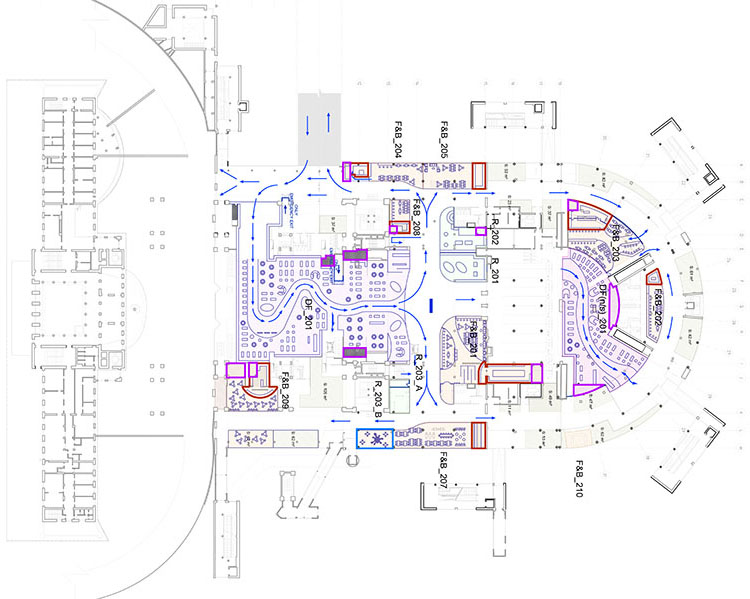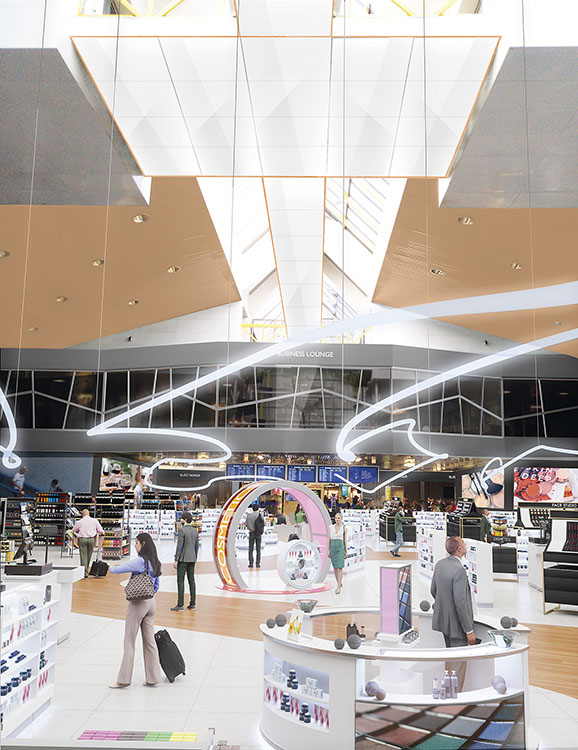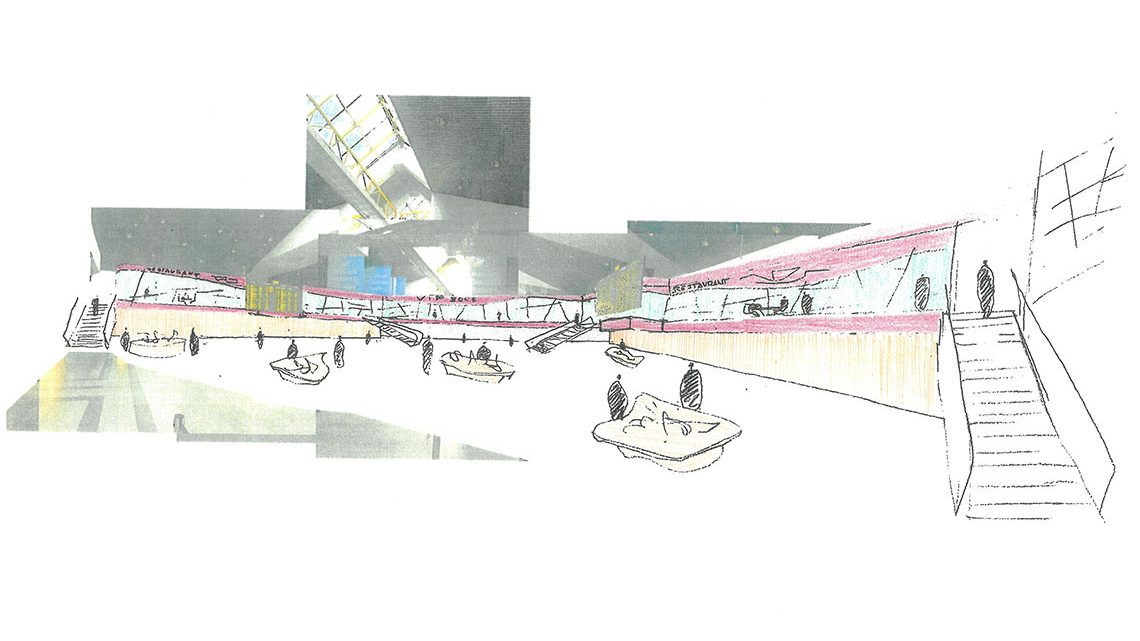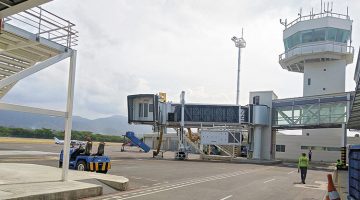Airport shops and restaurants play an important role in providing passengers with everything to meet their basic needs. A varied and large offering, with properly designed and attractive spaces, will make the overall passenger experience more pleasant, which will increase passenger spending and consequently, the airport will see an increase in revenue. Careful planning is required to achieve these objectives.
In 2020, Ineco completed a commercial plan for Vilnius International Airport, demonstrating the company’s extensive experience in the development of commercial spaces in airports, the result of almost two decades of collaboration with the airport manager Aena, and other projects carried out at the Luanda and El Salvador international airports, among others.
The work was developed in three phases, starting with the analysis of the characteristics of the airport such as its passenger profile and an analysis of the existing commercial offering and an initial proposal for commercial sizing. In the next stage, different proposals for the distribution of spaces and the recommended commercial mix were drawn up. All of this ensures compliance with IATA technical recommendations, especially with respect to spaces in boarding lounges. Lastly, the general guidelines for functional interior design and the homogeneous and attractive façade design were presented, along with the general technical requirements for supplies and services. At this stage, a detailed business plan was presented for each of the commercial premises, including calculations of the necessary investments, operating costs, expected revenues and returns, as well as a proposal for fees and concession periods.
Portrait of an airport
Vilnius International Airport, managed by the state-owned Lithuanian Airports, is the country’s busiest airport. In 2019, it surpassed 5 million passengers and has experienced significant growth in recent years. The terminal is the product of three distinct architectural stages (1954, 1987 and 2007). According to the analysis performed, the three buildings are well integrated architecturally, with a bright interior space and high ceilings. The biggest problem detected was congestion, which is why a third expansion will be carried out in an annexed area, called T4, where the check-in and security processes will be carried out in the future, leaving the entire area of the existing terminal for boarding.
The existing commercial area totals about
3,600 m2, which is equivalent to about 724 m² per million passengers. The airside/groundside distribution is 79%-21%, which is considered adequate and within the reference values. This is because passengers spend more time airside. Architectural constraints determine where the passenger flow, which has been studied in detail, will move since this defines the layout of available offerings. In this initial stage, Ineco’s consulting team also analysed the airport’s operational and socio-demographic profile, the concessionaires and the passengers, 40% of whom travel for leisure, which means that, unlike business passengers, they arrive at the airport earlier and spend more time there. Another factor analysed in phase one of the plan was the sizing of the commercial area of Vilnius airport, calculating the square metres of commercial space per million passengers.
Ineco designed the most suitable layout and commercial mix for the enlargement and remodeling of Vilnius airport
Location is (almost) everything
In the second stage of development of the commercial plan, Ineco’s team prepared a design of the distribution of the different spaces or layout, with several alternatives, and a proposal of the most suitable and balanced set of business lines for Vilnius airport, known as the commercial mix. This was done based on the walk-through duty-free stores in Dubai, Sydney, Madrid or Barcelona, among others, and the latest trends in retail and F&B (Food & Beverage) areas at reference airports in European cities such as Amsterdam, Frankfurt or London, and other nearby cities with similar culture such as Copenhagen, Riga or Tallinn. The commercial offering of the city of Vilnius was also studied, where the sale of one of the most typical national products of Lithuania –amber– stands out.
The walk-through store concept has spread to airports around the world and is considered the most commercially effective design. Nowadays, at the Vilnius airport, there is already a quite new and modern duty free walk-through shop, although an inevitable flow split occurs there, which, together with the small size, limits its potential. The proposal is therefore to improve the location and size of the shopping area, increasing it to around 1,500 m2. The existing retail offering in Vilnius is minimal, so the proposal is to improve it in terms of variety to enhance the shopping experience. In addition, updating to follow some of the latest trends is also recommended, such as speciality retail shops that encourage shopping by offering a distinctive product: the Ferrari shops in Italian airports, the tulip store at Schiphol or the gold jewellery store in Dubai, for example.
As far as F&B areas are concerned, increasing the passenger’s ‘perception of choice’ is also recommended, since the larger the perceived variety, the greater their satisfaction and therefore the more they will end up spending. Recent restaurant trends that have been studied at major European airports include food trucks, ‘local flavours’ (branches of popular local restaurants), ‘farmer’s markets’ for local and seasonal products, to-go gourmet meals for in-the-air consumption (grab&go), celebrity chef restaurants, high-tech restaurants equipped with tablets for business passengers, pop-up restaurants and sports bars. There is also a trend towards food-courts, common areas shared between several nearby F&B points, which enhances the perception of variety, especially in terminals with limited space as is the case in Vilnius.

Commercial design of the main floor, with the proposed distribution of retail, F&B and duty free areas, strategically located in the path of the passenger flow.
The location and the most suitable sizing for each business line have been studied in detail, while always seeking the maximum possible visibility and also clustering the shops around a commercial plaza in order to generate a critical mass that will improve sales performance. The ‘anchor’ effect or attraction generated by F&B areas and some non-commercial services such as toilets, seating areas, children’s playground, currency exchange, etc., which, regardless of their location, attract passengers by covering basic needs, was taken into account in the layout. Synergies between the different establishments were also considered: for example, jewellery shops are good ‘neighbours’ to perfume shops or upmarket restaurants, but not to toilets, while cafes are a good commercial fit next to establishments such as press or bookshops, as well as next to seating areas.
Another key to efficient commercial design is to maximise the time spent in the commercial area while reducing passenger stress: this is at its highest level just before boarding. Installing flight information screens with boarding notices in this area helps to reassure passengers, which improves their willingness to shop. In addition to this, it has been suggested that the boarding gates be announced at the required time, and not too early, in order to make it easier to remain in the commercial areas.
Architectural design of interiors and façades
In the third and final stage of the commercial plan, the interior designs of the commercial premises and a joint vision of the façades of the establishments were developed. Ineco’s architectural team developed a façade design with up to eight types of sections, with the aim of homogenising the space and creating a welcoming ambience that will attract customers, in an architecturally integrated space. For instance, the undulating design of the stores avoids the feeling of an ‘endless corridor’, while in the other areas an open design invites customers who have little time to visit. For interiors, the use of floors that are suitable for intensive airport use, a bright display and clearly visible prices are recommended. In terms of materials, robust materials with high-quality finishes are recommended, and they should follow the same design trends applied in the new expansion, where the use of wood predominates.
Lighting is particularly important, since it helps to highlight the products, guide the customer through the store and create atmosphere. Ceilings are also very important as they serve to conceal conduits and wiring and together with lighting, are essential for creating visual effects. Flooring must be durable and at the same level as the terminal. The plan included design proposals for all of the stores included in the commercial mix.
The three main recommendations for the façades were to maintain the architectural merit of the space, to offer interesting and contemporary designs and to use the exterior as a showcase, taking special care with the front signage. Lastly, the plan includes general recommendations for the technical design in terms of the water and electricity supply, air conditioning, smoke extraction systems, fire protection systems and data connection.
A commercial mix ‘tailor-made’ for Vilnius

Mock-up of the future duty free walk-through, which is currently located in the check-in area. The open space concept, the lighting and the use of wood are the main features of the design, creating a cosy and attractive atmosphere.
In the commercial mix proposed for Vilnius airport, the main recommendations include, among others, the incorporation of ‘accessories & fashion’ and ‘electronic, sports and toys & games’ categories in the duty free shop (or as an independent shop in some cases), as well as souvenirs and a delicatessen in the commercial plaza, all of which have high potential demand. The opening of an amber costume jewellery shop, just like those in the most emblematic streets of the city, is also recommended.
The implementation of ‘bar/pub’ and ‘coffee shop’ concepts, which are in high potential demand among passengers, is also proposed. The creation of a fast food point in the commercial plaza was also suggested, with an ‘anchor’, which could be an international burger brand, as well as other points that broaden the existing offerings, such as a Japanese restaurant or a bakery.






